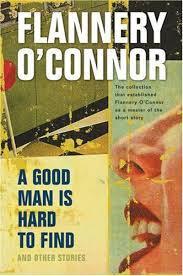When I sat down this afternoon to think about what post I could write, I had so far that day a) been to the dentist and b) had to listen to my son in tears over skype because his ex-girlfriend is moving in with her new man. In short, not much fun had been had. So I thought, I know what I’ll do, I’ll read a famous short story, something that will take up my thoughts for a while and jolt me into a critical analysis and thus lift my spirits. And casting about my books, I decided to read Flannery O’Connor’s classic, ‘A Good Man Is Hard To Find’. Sigh. Well, my mother told me there’d be days like these.

Flannery O’Connor’s tale concerns a manipulative old biddy who is trying to pursue her desires exactly as they rise up in her without much thought to the consequences, clearly a lifelong strategy that is about to end in disaster. She lives with her son and his family, who are tired of her conniving ways but have chosen endurance above all else. The family is setting off on a trip to Florida but the grandmother has decided she’d rather go to Tennessee and is doing her best to gain this outcome, essentially by pointing out to her relatives that a killer named The Misfit is on the loose in Florida: ‘I wouldn’t take my children in any direction with a criminal like that aloose in it. I couldn’t answer to my conscience if I did.’ Given her strategies have gained her zero credence in the household, this is dismissed as a piece of nonsense.
So the family sets off in the morning, grandmother first to get in the car and smuggling along her cat who she knows does not have permission to come. There’s plenty of back seat comedy with the children and the grandmother that ends with her deciding there’s a house she’d like to visit en route and telling the children (untruthfully) that it has a secret panel. The kids kick up enough fuss that their father changes direction, but as the grandmother realises to her chagrin that the house she’s thinking of is in a different state entirely, she lets the cat loose and they crash the car in the subsequent confusion.
Pootling over the hill, witness to their accident, comes another car. The family flags it down and out steps none other than The Misfit and his henchman, who the grandmother identifies out loud, alas. So up until now the grandmother has been like a small child herself, prodding and poking in the vain attempt to get some attention and to have things her way. And now, she’s managed to tweak the tail of a tiger and there is no going back. Now, in this too-late stage, the grandmother does her best to appease the Misfit, telling him over and over that she can see he’s a good man, and that if he prays, his life will be better. The Misfit has his own twisted tale to tell, of being punished for something he knows he did, but can’t recall what. This seems to offer enough of a flaw in the workings of justice to let him feel hard done by, and to kill without remorse. He picks off the family one by one and, when the grandmother reaches out to him and tells him he could be her son, he kills her, too.
My first impressions? I’ve never read a short story before that attempts to combine a serial killer with an obscure religious sermon. Jo Nesbo meets C. S. Lewis in the deep South. I can see that this is the kind of story to stick in the literary craw because the events are so horrific they demand that some sort of interpretation is made in the name of redeeming the material. And yet not enough information is provided actually to make an interpretation. Apparently, a great deal hinges on what the reader thinks is happening to the grandmother when she touches the Misfit and calls him her own child. Are we witnessing some sort of epiphany on her part? Or is this another attempt at a self-serving manipulation? Or is it simply that, now that the killer has put on her dead son’s shirt, she is confused by terror? The ambiguity is continued by the Misfit’s pronouncement over her body that she would have been a good woman ‘if it had been somebody there to shoot her every minute of her life.’ Does this mean, as some suggest, that only extreme circumstances could jolt the grandmother into goodness, or does it mean that she would have needed a gun against her head on a daily basis to keep her good?

It’s certainly true that once you’ve read this story, you’ll never forget it. For shock value, Flannery O’Connor could have taught Quentin Tarantino a thing or two. But is there more artistry in it than there is horror? I’m not entirely convinced. My experience, though, was that the horror made me shift my thinking about the story onto an abstract plane, and so I engaged with it as a piece of complex and obscure art, rather than a nasty and upsetting tale. So I suppose it did get my mind off my own troubles. Credit where it’s due!
